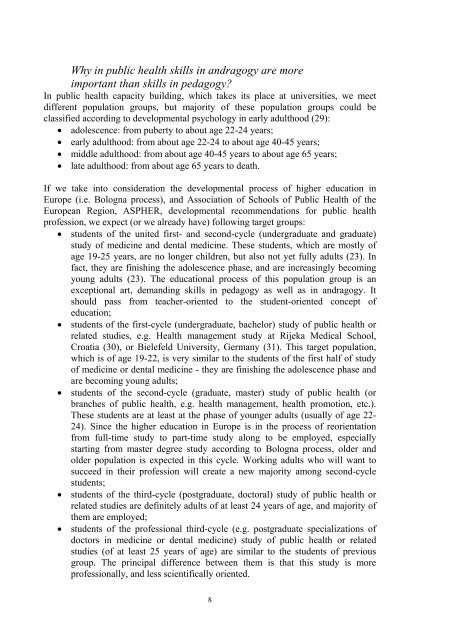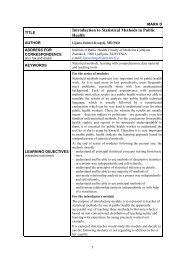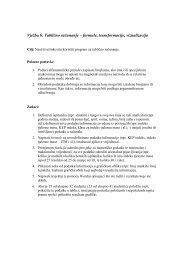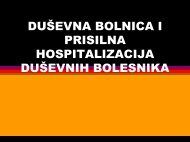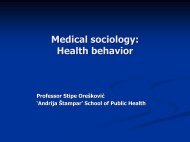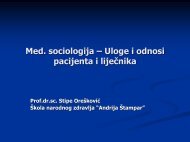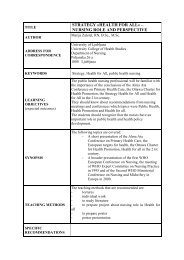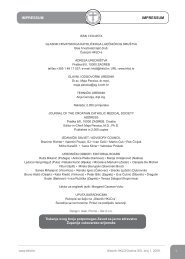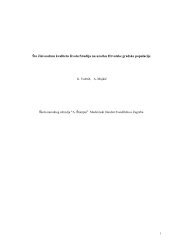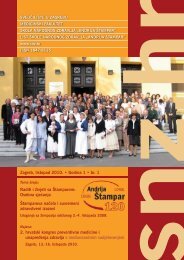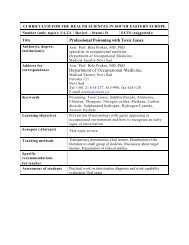STATISTINE METODE V EPIDEMIOLOGIJI
STATISTINE METODE V EPIDEMIOLOGIJI
STATISTINE METODE V EPIDEMIOLOGIJI
You also want an ePaper? Increase the reach of your titles
YUMPU automatically turns print PDFs into web optimized ePapers that Google loves.
Why in public health skills in andragogy are more<br />
important than skills in pedagogy<br />
In public health capacity building, which takes its place at universities, we meet<br />
different population groups, but majority of these population groups could be<br />
classified according to developmental psychology in early adulthood (29):<br />
• adolescence: from puberty to about age 22-24 years;<br />
• early adulthood: from about age 22-24 to about age 40-45 years;<br />
• middle adulthood: from about age 40-45 years to about age 65 years;<br />
• late adulthood: from about age 65 years to death.<br />
If we take into consideration the developmental process of higher education in<br />
Europe (i.e. Bologna process), and Association of Schools of Public Health of the<br />
European Region, ASPHER, developmental recommendations for public health<br />
profession, we expect (or we already have) following target groups:<br />
• students of the united first- and second-cycle (undergraduate and graduate)<br />
study of medicine and dental medicine. These students, which are mostly of<br />
age 19-25 years, are no longer children, but also not yet fully adults (23). In<br />
fact, they are finishing the adolescence phase, and are increasingly becoming<br />
young adults (23). The educational process of this population group is an<br />
exceptional art, demanding skills in pedagogy as well as in andragogy. It<br />
should pass from teacher-oriented to the student-oriented concept of<br />
education;<br />
• students of the first-cycle (undergraduate, bachelor) study of public health or<br />
related studies, e.g. Health management study at Rijeka Medical School,<br />
Croatia (30), or Bielefeld University, Germany (31). This target population,<br />
which is of age 19-22, is very similar to the students of the first half of study<br />
of medicine or dental medicine - they are finishing the adolescence phase and<br />
are becoming young adults;<br />
• students of the second-cycle (graduate, master) study of public health (or<br />
branches of public health, e.g. health management, health promotion, etc.).<br />
These students are at least at the phase of younger adults (usually of age 22-<br />
24). Since the higher education in Europe is in the process of reorientation<br />
from full-time study to part-time study along to be employed, especially<br />
starting from master degree study according to Bologna process, older and<br />
older population is expected in this cycle. Working adults who will want to<br />
succeed in their profession will create a new majority among second-cycle<br />
students;<br />
• students of the third-cycle (postgraduate, doctoral) study of public health or<br />
related studies are definitely adults of at least 24 years of age, and majority of<br />
them are employed;<br />
• students of the professional third-cycle (e.g. postgraduate specializations of<br />
doctors in medicine or dental medicine) study of public health or related<br />
studies (of at least 25 years of age) are similar to the students of previous<br />
group. The principal difference between them is that this study is more<br />
professionally, and less scientifically oriented.<br />
8


